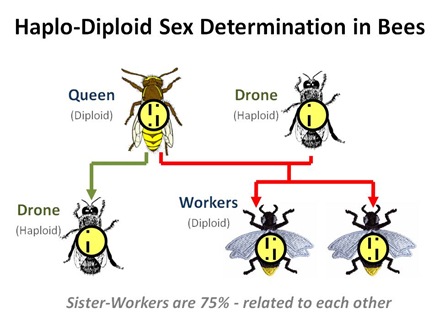Definition for Difference between revisions of "Haplodiploidy"
From Biology Forums Dictionary
(Created page with "A genetic system in which females develop from fertilized eggs and are diploid but males develop from unfertilized eggs and are haploid.") |
|||
| (One intermediate revision by the same user not shown) | |||
| Line 1: | Line 1: | ||
| − | A genetic system in which females develop from fertilized eggs and are diploid but males develop from unfertilized eggs and are haploid. | + | 1) A genetic system in which females develop from fertilized eggs and are diploid but males develop from unfertilized eggs and are haploid. |
| + | |||
| + | 2) Haplodiploidy is a mechanism of sex determination that is common in the hymenoptera but also found in some other groups. In this system sex is determined by the number of sets of chromosomes an offspring receives. Fertlized eggs develop as females, and unfertilized eggs develop as males. This means that the males have half the number of chromosomes that a female have - hence the name haplodiploidy for this system. In this system males have no father and cannot have sons, but have grandfathers and can have grandsons (think about it). Also because males are already haploid all the sperm they produce is identical. | ||
| + | |||
| + | http://1.bp.blogspot.com/-1W6QqerG77w/TWQqeStjecI/AAAAAAAAA74/rjs-II-RNk8/s1600/HaploDiploid.jpg | ||
| + | |||
| + | Haplodiploidy has important consequences that seem to affect social behavior. Here's a nice description: | ||
| + | |||
| + | 1) If a queen mates only once, her daughters are highly related to each other (called supersisters), because the father's sperm are all identical.<br>2) A female is more related to her sisters (on average, 75% similar) than she is to her own daughters (on average 50% similar).<br>3) A female is more related to her son (50 % similar) than she is to a brother (on average, 25% similar).<br> | ||
| + | |||
| + | These three factors combine to create a condition in which it may be more advantageous, evolutionarily speaking, for a female to help her mother produce sisters (to the female in question) than to produce her own daughters. Thus haplodiploidy opens the way for the evolution of a worker caste, devoted to helping their mother. If workers evolve under these conditions, then we would expect: | ||
| + | |||
| + | *That all workers will be female (males have no special pattern of relatedness in a haplodiploid system that would make working advantageous to them | ||
| + | *That workers will help their mother to lay and rear females, but | ||
| + | *That workers would prefer to lay their own male offspring, rather than rear brothers<br> | ||
| + | |||
| + | In fact, Hymenoptera workers are uniformly female and conflict between the queen and the workers over who lays the males eggs in a nest is common. The role of haplodiploidy in the evolution of worker Hymenoptera fits into an overall theory of how genetic similarity affects social behavior called kin selection which was developed by Bill Hamilton. | ||
Latest revision as of 21:24, 9 May 2013
1) A genetic system in which females develop from fertilized eggs and are diploid but males develop from unfertilized eggs and are haploid.
2) Haplodiploidy is a mechanism of sex determination that is common in the hymenoptera but also found in some other groups. In this system sex is determined by the number of sets of chromosomes an offspring receives. Fertlized eggs develop as females, and unfertilized eggs develop as males. This means that the males have half the number of chromosomes that a female have - hence the name haplodiploidy for this system. In this system males have no father and cannot have sons, but have grandfathers and can have grandsons (think about it). Also because males are already haploid all the sperm they produce is identical.

Haplodiploidy has important consequences that seem to affect social behavior. Here's a nice description:
1) If a queen mates only once, her daughters are highly related to each other (called supersisters), because the father's sperm are all identical.
2) A female is more related to her sisters (on average, 75% similar) than she is to her own daughters (on average 50% similar).
3) A female is more related to her son (50 % similar) than she is to a brother (on average, 25% similar).
These three factors combine to create a condition in which it may be more advantageous, evolutionarily speaking, for a female to help her mother produce sisters (to the female in question) than to produce her own daughters. Thus haplodiploidy opens the way for the evolution of a worker caste, devoted to helping their mother. If workers evolve under these conditions, then we would expect:
- That all workers will be female (males have no special pattern of relatedness in a haplodiploid system that would make working advantageous to them
- That workers will help their mother to lay and rear females, but
- That workers would prefer to lay their own male offspring, rather than rear brothers
In fact, Hymenoptera workers are uniformly female and conflict between the queen and the workers over who lays the males eggs in a nest is common. The role of haplodiploidy in the evolution of worker Hymenoptera fits into an overall theory of how genetic similarity affects social behavior called kin selection which was developed by Bill Hamilton.
